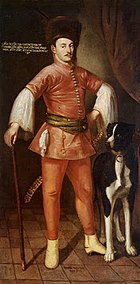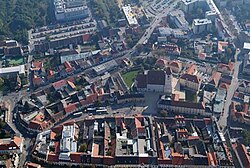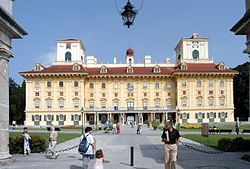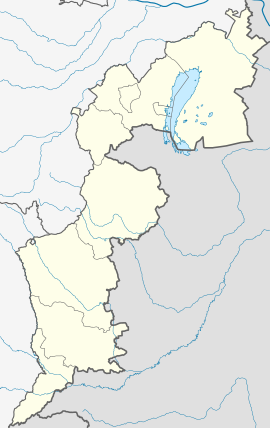Eisenstadt
Eisenstadt | |
|---|---|
|
Clockwise from top: aerial view of the city, state government building,Schloss Esterházy,calvary withBergkirche | |
| Coordinates:47°51′N16°31′E/ 47.850°N 16.517°E | |
| Country | |
| State | Burgenland |
| District | Statutory city |
| Government | |
| •Mayor | Thomas Steiner(ÖVP) |
| Area | |
| • Total | 42.88 km2(16.56 sq mi) |
| Elevation | 182 m (597 ft) |
| Population (2018-01-01)[2] | |
| • Total | 14,476 |
| • Density | 340/km2(870/sq mi) |
| Time zone | UTC+1(CET) |
| • Summer (DST) | UTC+2(CEST) |
| Postal code | 7000 |
| Area code | 02682 |
| Vehicle registration | E |
| Budget | €42.256 million (2021)[3] |
| Expenditure | €42.255 million (2021)[4] |
| Website | eisenstadt.gv.at |
Eisenstadt(German pronunciation:[ˈaɪzn̩ʃtat];Austro-Bavarian:Eisnstod;Hungarian:Kismarton;Croatian:Željezni gradorŽeljezno;Slovene:Železno) is the capital city of theAustrian stateofBurgenland.With a population of 15,074 (as of 2023), it is the smallest state capital and the 38th-largest city in Austria overall. It lies at the foot of theLeitha Mountainshill range.
From 1648 to 1921, Kismarton/Eisenstadt was part of theHabsburg Empire'sKingdom of Hungaryand the seat of theHungarian noble familyEszterházy.During this time, the composerJoseph Haydnlived and worked in Eisenstadt as a court musician under thepatronageof the Esterházy family. After the cessation of Burgenland to Austria in 1921, the city became the province's capital in 1925. As the state capital of Burgenland, it functions as a center of public administration and services[5][6]and is the seat of three institutes of higher education.
Geography[edit]
Eisenstadt lies on a plain leading down to the riverWulka,at the southern foot of theLeitha Mountains,about 12 kilometres (7 miles) from theHungarianborder.
Subdivisions[edit]
Eisenstadt is divided into three districts(Ortsteile):
- Eisenstadt-Stadt (Eisenstadt proper)
- Kleinhöflein im Burgenland (Hungarian:Kishöflány;Croatian:Mala Holovajna) – a town that lies to the west of Eisenstadt proper
- St. Georgen am Leithagebirge(Lajtaszentgyörgy;Svetojurje) – a town that lies to the east of Eisenstadt proper
Furthermore, Eisenstadt is divided into fiveKatastralgemeinden:
- Eisenstadt-Stadt
- Oberberg, or Oberberg-Eisenstadt (Hungarian:Felsőkismartonhegy;Croatian:Željezno Brig) – the northern area of Eisenstadt starting beyond the Jewish quarter
- Unterberg, or Unterberg-Eisenstadt (Alsókismartonhegy;Željezno Donji Brig) – the southern area of Eisenstadt starting beyond the Kalvarienbergplatz & the Ruster Straße and including the Jewish quarter
- Kleinhöflein im Burgenland
- St. Georgen am Leithagebirge
Other informal areas of the city include Wiesäcker and Lobäcker, which lie south of the Eisbach, a tributary of the Wulka. The city is surrounded by thedistrict(Bezirk) ofEisenstadt-Umgebung.
The city previously included the districts(Ortsteile)of Eisenstadt-Stadt, Eisenstadt-Oberberg, Eisenstadt-Unterberg, and Eisenstadt-Schloßgrund (Kismartonváralja).
Nearby municipalities[edit]
- Großhöflein,Müllendorf,Steinbrunn,Neufeld/LeithaandEbenfurth
- Hornstein
- Wulkaprodersdorf,Trausdorf/Wulka(on theWulkaand Eisbach)
Climate[edit]
| Climate data for Eisenstadt (1981–2010) | |||||||||||||
|---|---|---|---|---|---|---|---|---|---|---|---|---|---|
| Month | Jan | Feb | Mar | Apr | May | Jun | Jul | Aug | Sep | Oct | Nov | Dec | Year |
| Record high °C (°F) | 20.5 (68.9) |
21.1 (70.0) |
24.1 (75.4) |
27.2 (81.0) |
33.2 (91.8) |
36.1 (97.0) |
38.7 (101.7) |
38.4 (101.1) |
33.7 (92.7) |
28.0 (82.4) |
21.9 (71.4) |
19.8 (67.6) |
38.7 (101.7) |
| Mean daily maximum °C (°F) | 3.1 (37.6) |
5.3 (41.5) |
10.4 (50.7) |
16.1 (61.0) |
21.1 (70.0) |
24.0 (75.2) |
26.7 (80.1) |
26.1 (79.0) |
20.9 (69.6) |
15.0 (59.0) |
8.3 (46.9) |
3.5 (38.3) |
15.0 (59.0) |
| Daily mean °C (°F) | −0.1 (31.8) |
1.3 (34.3) |
5.5 (41.9) |
10.7 (51.3) |
15.7 (60.3) |
18.8 (65.8) |
21.0 (69.8) |
20.2 (68.4) |
15.5 (59.9) |
10.2 (50.4) |
4.9 (40.8) |
0.8 (33.4) |
10.4 (50.7) |
| Mean daily minimum °C (°F) | −2.8 (27.0) |
−1.7 (28.9) |
1.8 (35.2) |
6.0 (42.8) |
10.5 (50.9) |
13.7 (56.7) |
15.7 (60.3) |
15.5 (59.9) |
11.5 (52.7) |
6.9 (44.4) |
2.3 (36.1) |
−1.6 (29.1) |
6.5 (43.7) |
| Record low °C (°F) | −21.6 (−6.9) |
−19.8 (−3.6) |
−19.2 (−2.6) |
−2.8 (27.0) |
1.2 (34.2) |
3.7 (38.7) |
6.9 (44.4) |
6.8 (44.2) |
2.1 (35.8) |
−5.9 (21.4) |
−12.3 (9.9) |
−17.8 (0.0) |
−21.6 (−6.9) |
| Averageprecipitationmm (inches) | 38 (1.5) |
34 (1.3) |
59 (2.3) |
52 (2.0) |
77 (3.0) |
90 (3.5) |
77 (3.0) |
91 (3.6) |
78 (3.1) |
53 (2.1) |
57 (2.2) |
51 (2.0) |
758 (29.8) |
| Average snowfall cm (inches) | 13 (5.1) |
10 (3.9) |
6 (2.4) |
0 (0) |
0 (0) |
0 (0) |
0 (0) |
0 (0) |
0 (0) |
0 (0) |
5 (2.0) |
12 (4.7) |
46 (18) |
| Averagerelative humidity(%)(at 14:00) | 70.5 | 62.6 | 56.5 | 50.4 | 52.9 | 53.5 | 50.2 | 51.4 | 56.0 | 62.3 | 70.6 | 74.7 | 59.3 |
| Mean monthlysunshine hours | 73 | 107 | 145 | 204 | 246 | 245 | 272 | 254 | 188 | 139 | 72 | 53 | 1,999 |
| Percentpossible sunshine | 27.7 | 38.3 | 41.0 | 51.8 | 55.2 | 54.4 | 59.7 | 60.1 | 51.8 | 42.7 | 26.6 | 21.1 | 44.2 |
| Source:Central Institute for Meteorology and Geodynamics[7][8][9][10][11] | |||||||||||||
| Climate data for Eisenstadt (1971–2000) | |||||||||||||
|---|---|---|---|---|---|---|---|---|---|---|---|---|---|
| Month | Jan | Feb | Mar | Apr | May | Jun | Jul | Aug | Sep | Oct | Nov | Dec | Year |
| Record high °C (°F) | 18.8 (65.8) |
19.7 (67.5) |
27.4 (81.3) |
27.2 (81.0) |
30.8 (87.4) |
36.1 (97.0) |
36.4 (97.5) |
37.0 (98.6) |
33.7 (92.7) |
26.4 (79.5) |
21.9 (71.4) |
19.8 (67.6) |
37.0 (98.6) |
| Mean daily maximum °C (°F) | 2.8 (37.0) |
5.3 (41.5) |
10.4 (50.7) |
15.3 (59.5) |
20.6 (69.1) |
23.4 (74.1) |
25.9 (78.6) |
25.7 (78.3) |
20.9 (69.6) |
14.8 (58.6) |
7.7 (45.9) |
4.0 (39.2) |
14.7 (58.5) |
| Daily mean °C (°F) | −0.4 (31.3) |
1.3 (34.3) |
5.5 (41.9) |
9.9 (49.8) |
15.1 (59.2) |
18.1 (64.6) |
20.2 (68.4) |
19.8 (67.6) |
15.3 (59.5) |
9.8 (49.6) |
4.3 (39.7) |
1.1 (34.0) |
10.0 (50.0) |
| Mean daily minimum °C (°F) | −2.9 (26.8) |
−1.6 (29.1) |
1.9 (35.4) |
5.5 (41.9) |
10.1 (50.2) |
13.2 (55.8) |
15.2 (59.4) |
15.1 (59.2) |
11.4 (52.5) |
6.5 (43.7) |
1.7 (35.1) |
−1.2 (29.8) |
6.2 (43.2) |
| Record low °C (°F) | −21.6 (−6.9) |
−19.8 (−3.6) |
−19.2 (−2.6) |
−4.0 (24.8) |
−1.6 (29.1) |
3.7 (38.7) |
6.2 (43.2) |
3.8 (38.8) |
2.1 (35.8) |
−5.3 (22.5) |
−12.3 (9.9) |
−17.8 (0.0) |
−21.6 (−6.9) |
| Averageprecipitationmm (inches) | 33.7 (1.33) |
29.7 (1.17) |
45.1 (1.78) |
51.9 (2.04) |
62.6 (2.46) |
71.2 (2.80) |
66.7 (2.63) |
59.8 (2.35) |
58.8 (2.31) |
43.7 (1.72) |
53.6 (2.11) |
41.2 (1.62) |
618.0 (24.33) |
| Average snowfall cm (inches) | 12.0 (4.7) |
8.8 (3.5) |
6.4 (2.5) |
0.8 (0.3) |
0.0 (0.0) |
0.0 (0.0) |
0.0 (0.0) |
0.0 (0.0) |
0.0 (0.0) |
0.0 (0.0) |
5.0 (2.0) |
14.1 (5.6) |
47.1 (18.5) |
| Average precipitation days(≥ 1.0 mm) | 6.1 | 5.9 | 8.1 | 7.7 | 8.5 | 9.3 | 8.5 | 8.2 | 7.0 | 5.9 | 7.8 | 6.9 | 89.9 |
| Averagerelative humidity(%)(at 14:00) | 72.8 | 65.1 | 57.0 | 51.7 | 52.8 | 53.4 | 50.7 | 51.1 | 56.2 | 61.8 | 71.2 | 74.5 | 59.9 |
| Mean monthlysunshine hours | 68.9 | 105.8 | 136.1 | 188.0 | 237.1 | 232.5 | 252.3 | 244.0 | 176.2 | 136.3 | 70.4 | 50.1 | 1,897.7 |
| Percentpossible sunshine | 26.2 | 37.9 | 38.6 | 47.7 | 53.5 | 52.1 | 55.8 | 57.8 | 48.4 | 41.8 | 25.9 | 20.3 | 42.2 |
| Source:Central Institute for Meteorology and Geodynamics[12] | |||||||||||||
Names and etymology[edit]

The city's name means "Iron City" and was first recorded in 1118 asCastrum ferrum,referring to the history of iron mining and iron trade in the area. The first written mention of the town is from 1264 as "minor Mortin", matching theHungarianname, Kismarton, which recallsMartin of Tours,the patron saint of the main church.
History[edit]
Archeological finds prove that the Eisenstadt area was already settled in theHallstattperiod.CeltsandRomanssettled somewhat later. During theMigration Period,the area was settled by differentGermanic tribesand theHuns.Around 800, during the reign ofCharlemagne,settlement by theBavariibegan. The territory became part of theKingdom of Hungaryin the 11th century.
The fortress built on the original earth works was destroyed by the troops of MargraveLeopold IIIofAustria.In 1241, it was destroyed by theMongolinvaders. In 1373, the town came into the possession of theKanizsaifamily, who rebuilt the walls surrounding the town and built a fortress at the site of the present day castle between 1388 and 1392. In 1388, Eisenstadt was given the right to hold markets byEmperor Sigismund.
From 1440 ArchdukeAlbert VI of Austriaheld the town as collateral for a loan. In 1451,Matthias Corvinusceded it toFrederick III, Holy Roman Emperorin return for theHoly Crown of Hungary.Matthias Corvinus reconquered it by force in 1482, butMaximilian Iacquired it again in 1490. It remained underHabsburgrule until 1622; however, theOttoman Empirebriefly conquered Kismarton in 1529 and 1532 during their advances on the city ofVienna(seeOttoman wars in Europe). It was destroyed by fire in 1589.
In 1648, it passed under the rule of theEsterházy family.TheseHungarianprinces permanently changed the face of the city due to their extensive construction, especially on their castle,Schloss Esterházy.During this period, the city was captured by the army ofImre Thökölyin 1683, and it saw the defeat of the rebelkurucarmy ofSándor Károlyiby theHabsburgsin 1704. It was again destroyed by fire in 1776.
The appointment ofJoseph Haydnas the prince'sHofkapellmeister(court orchestra director, composing and performing music) began the great artistic period in the city's history. In 1809, Eisenstadt was occupied byFrenchtroops during theNapoleonic Wars;in 1897, it was joined to the railway network.
Until the end ofWorld War I,it was the seat of Kismarton district in Sopron county in theKingdom of Hungary.Without plebiscite, the city and the entire Hungarian territory of Burgenland (with the exception of the city ofSopronand 11 other villages in which referendums were held) was annexed to Austria by theSaint-GermainandTreaties of Trianonin 1921. Since 30 April 1925, Eisenstadt has been the seat of the Burgenland state government and thus the state capital. DuringWorld War II,Eisenstadt was heavily bombarded. On 2 April 1945, it was captured bySoviettroops of the3rd Ukrainian Frontin the course of theVienna Offensive,and the city remained under Soviet occupation until 1955. In 1960, it became the see of theRoman Catholic Diocese of Eisenstadt.
Politics[edit]
The currentmayorof Eisenstadt isThomas Steiner(ÖVP).
The district council is composed as follows (as of 2022[update]):
- Austrian People's Party(ÖVP): 17 seats
- Social Democratic Party of Austria(SPÖ): 8 seats
- Austrian Green Party(Grüne): 3 seats
- Freedom Party of Austria(FPÖ): 1 seat
The total annual city budget of Eisenstadt in 2021 is €42.256.600 with total expenditure of €42.255.800.[13]
Main sights[edit]
Secular buildings[edit]

- Schloss Esterházy
- Schlosspark
- Orangerie
- Leopoldinentempel
- Gloriette,the former Esterházy hunting lodge.
- City Hall
- Cathedral Bastion andPowder tower
- Martinkaserne,19th-century military barracks
Religious buildings and districts[edit]

- Bergkirche,housingHaydn's tomb
- Eisenstadt Cathedral,late Gothic church dedicated toSaint Martin
- Franziskanerkirche,baroque Franciscan church containing the crypt of theEsterházy family
- Krankenhaus Barmherzige BrüderandBarmherzigenkirche Hl. Antonius von Padua,baroque hospital and church dedicated toAnthony of Padua
- Jewish quarter(1732–1938, 1945–)[14]
- Privatesynagoguelocated within theAustrian Jewish Museum
- Old and new Jewish cemetery

Museums[edit]
- Haydnmuseum,a museum dedicated toJoseph Haydn,who lived in the building between 1766 and 1778.
- Landesmuseum,regional museum
- Austrian Jewish Museum
- Diözesanmuseum,museum of the local Roman Catholic diocese
- Feuerwehrmuseum,museum of the fire department
Education[edit]
Eisenstadt is the seat of theuniversity of applied sciencesFH Burgenland,[15]thecollege of educationPH Burgenland,[16]and themusic schoolJoseph-Haydn-Privathochschule Burgenland.[17]
Culture[edit]
Eisenstadt formerly hosted aJoseph Haydnfestival, theHaydn Festspiele,a viniculture festival, theFest der 1000 Weine,and a tournament of theWorld Athletics Continental Tour,the Austrian Open.
Twin towns — sister cities[edit]
Eisenstadt istwinnedwith:
 Bad Kissingen,Bavaria,Germany
Bad Kissingen,Bavaria,Germany Colmar,Haut-Rhin,Grand Est,France
Colmar,Haut-Rhin,Grand Est,France Manassas, Virginia,United States
Manassas, Virginia,United States Lignano Sabbiadoro,Udine,Friuli-Venezia Giulia,Italy
Lignano Sabbiadoro,Udine,Friuli-Venezia Giulia,Italy Sanuki,Japan
Sanuki,Japan Raleigh, North Carolina,United States
Raleigh, North Carolina,United States Sopron,Hungary
Sopron,Hungary
Notable people[edit]



Natives[edit]
- Paul I, Prince Esterházy(1635–1713), the first Prince Esterházy of Galántha from 1687 to 1713,[18]
- Paul II Anton, Prince Esterházy,(1711–1762), a Hungarian prince, soldier and patron of music
- Isaiah Berlin(1719 or 1725 – 1799), a GermanTalmudistand rabbi.[19]
- Joseph Franz Weigl(1740–1820), cellist, father ofJoseph Weigl
- Joseph Weigl(1766–1846), composer and conductor
- Friedrich Bridgetower (1782-1813), composer, cellist, brother ofGeorge Bridgetower
- Ferdinand von Rosenzweig(1812–1892), an Austrian military officer and architect, worked in Mexico.
- Josef Hyrtl(1810–1894), anatomist.[20]
- Ferenc Markó(1832–1874), a Hungarian painter of landscapes; usually with figures
- Moritz Benedikt(1835–1920), neurologist
- Ferenc Farkas de Kisbarnak(1892–1980), Chief Scout of theHungarian Boy Scouts
- Gyula Farkas(1894–1958), a Hungarian literary historian and Finno-Ugric linguist
- Stefan Billes, (DE Wiki)(1909, Kleinhöflein – 2002) politician (SPÖ).
- Josef Kirchknopf, (DE Wiki)(born 1930, Kleinhöflein), politician (ÖVP)
- Martin Vukovich(born 1944), diplomat
- Maria Perschy(1938–2004), film and TV actress
- Rudolf Simek(born 1954), an Austrian philologist and religious studies scholar
- Andrea Fraunschiel(1955–2019), politician (ÖVP), and local mayor
- Johann Luif(born 1959, Kleinhöflein), an Austrian politician and military officer.
Sport[edit]
- Johann Dihanich(born 1958), football player, played over 330 games and 10 forAustria
- Thomas Mandl(born 1979), football player, played over 250 games and 13 forAustria
- Michael Mörz(born 1980), football player, played over 322 games and 12 forAustria
- Andreas Ivanschitz(born 1983), football player, played over 420 games and 69 forAustria
- Philipp Hosiner(born 1989), an Austrian footballer who has played over 280 games and 5 forAustria
- Marko Daňo(born 1994), Slovak ice hockey player, won team bronze at the2022 Winter Olympics
Other residents[edit]


- Mordecai Mokiach(ca. 1650–1724), a JewishSabbateanprophet andMessiah claimant
- Samson Wertheimer(1658–1724),chief rabbiof Hungary and Moravia, and rabbi of Eisenstadt.
- Meir Eisenstadt(1670–1744) rabbi of theSiebengemeinden,died locally
- Joseph Haydn(1732–1809), musician, born inRohrau.[21]
- Ignaz Pleyel(1757–1831), composer, from 1772 he became the pupil ofJoseph Haydnin Eisenstadt.[22]
- Akiva Eiger(1761–1837),rabbiand champion ofOrthodox Judaism.[23]
- Adam Liszt(1776–1827), musician, father ofFranz Liszt,played cello under the direction ofJoseph Haydn.
- Johann Nepomuk Hummel(1778–1837), an Austrian composer and virtuoso pianist.
- Leopold Löw(1811–1875), born inČerná Hora,Moravia,studied at theyeshivaof Eisenstadt
- Samuel Löw Brill(1814–1897), rabbi andTalmudicalscholar; born inBudapest;attendedyeshiva
- Isaac Hirsch Weiss(1815–1905),talmudist;born atVelké Meziříčí,Moravia; studied atyeshiva
- Azriel Hildesheimer(1820–1899), German rabbi, foundedTorah im Derech Eretz;from 1851 Rabbi of Eisenstadt
- Markus Horovitz(1844–1915), German rabbi and historian; rabbinical studies at theyeshiva
- Aaron Wise(1844–1896), rabbi, born inEger,Hungary, studied atyeshiva;father ofStephen Samuel Wise
- Emanuel Schreiber(1852–1932), American rabbi, born inLipník nad Bečvou,Moravia; attended localyeshiva
- Robert Musil(1880–1942), an Austrian philosophical writer.
- Fritz Spiegl(1926–2003), musician, journalist, broadcaster and humorist, attended the Gymnasium in Eisenstadt
- Paul Iby(born 1935), a reformist bishop at theRoman Catholic Diocese of Eisenstadt
As a surname[edit]
Eisenstadt(also Ajzenstat, Eisenstaedter, Asch, etc.),aJewish surname,derives from this city.[24]Some people with this surname or its variants include:
- Alfred Eisenstaedt{1898–1995), an American photographer and photojournalist.
- Meir Eisenstadt(ca. 1670 in Poznań – 1744 in Eisenstadt) author of rabbinic literature.
- Shmuel Eisenstadt(1923–2010), Israeli sociologist
- Stuart E. Eizenstat(born 1943), an American diplomat and attorney.
- Moses Asch(1905–1986), an American recording engineer and record executive
References[edit]
- ^"Dauersiedlungsraum der Gemeinden Politischen Bezirke und Bundesländer - Gebietsstand 1.1.2018".Statistics Austria.Retrieved10 March2019.
- ^"Einwohnerzahl 1.1.2018 nach Gemeinden mit Status, Gebietsstand 1.1.2018".Statistics Austria.Retrieved9 March2019.
- ^"Eisenstadt Ergebnishaushalt".offenerhaushalt.at(in German). 2021.Retrieved2021-04-02.
- ^"Eisenstadt Ergebnishaushalt".offenerhaushalt.at(in German). 2021.Retrieved2021-04-02.
- ^"Eisenstadt | Baroque Architecture, Burgenland & Music | Britannica".
- ^"Burgenland | Austria's Easternmost State & its History | Britannica".
- ^ "Klimamittel 1981–2010: Lufttemperatur"(in German). Central Institute for Meteorology and Geodynamics. Archived fromthe originalon 21 October 2019.Retrieved29 October2019.
- ^ "Klimamittel 1981–2010: Niederschlag"(in German). Central Institute for Meteorology and Geodynamics. Archived fromthe originalon 29 December 2014.Retrieved29 October2019.
- ^ "Klimamittel 1981–2010: Schnee"(in German). Central Institute for Meteorology and Geodynamics. Archived fromthe originalon 29 December 2014.Retrieved29 October2019.
- ^ "Klimamittel 1981–2010: Luftfeuchtigkeit"(in German). Central Institute for Meteorology and Geodynamics. Archived fromthe originalon 21 October 2019.Retrieved29 October2019.
- ^ "Klimamittel 1981–2010: Strahlung"(in German). Central Institute for Meteorology and Geodynamics. Archived fromthe originalon 29 December 2014.Retrieved29 October2019.
- ^"Klimadaten von Österreich 1971–2000 – Burgenland-Eisenstadt"(in German). Central Institute for Meteorology and Geodynamics. Archived fromthe originalon 12 October 2019.Retrieved29 October2019.
- ^"Eisenstadt Ergebnishaushalt".offenerhaushalt.at(in German). 2021.Retrieved2021-04-02.
- ^Filckr photos:Flickr,Flickr
- ^FH Burgenland website
- ^PH Burgenland
- ^"Joseph-Haydn-Privathochschule Burgenland".Archived fromthe originalon 2023-08-01.Retrieved2023-08-01.
- ^.Encyclopædia Britannica.Vol. 9 (11th ed.). 1911. p. 794.
see third para: His third son Pál [Paul] (1635–1713), prince palatine...
- ^.Encyclopædia Britannica.Vol. 3 (11th ed.). 1911. p. 785.
- ^Walsh, James Joseph(1910)..Catholic Encyclopedia.Vol. 7.
- ^Hadow, William Henry(1911)..Encyclopædia Britannica.Vol. 13 (11th ed.). pp. 109–111.
- ^.Encyclopædia Britannica.Vol. 21 (11th ed.). 1911. p. 840.
- ^.Encyclopædia Britannica.Vol. 9 (11th ed.). 1911. p. 12.
- ^Asch and its variants are an abbreviation for Eisenstadt. see"Ash".Jewish Encyclopedia.1906.
External links[edit]
- Official website(in German)
- Official tourism website
- Österreichisches Jüdisches Museum (Austrian Jewish Museum)(in German)
- Jewish Encyclopedia article on the Jewish community of Eisenstadt(in English)
- Schloss Esterházy (Esterházy Castle)(in German)
- Fachhochschul-Studiengänge BurgenlandUniversity of applied sciences.(in German)









